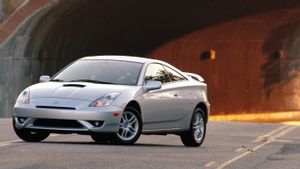JAKARTA - On January 29, 1886, Carl Benz filed a patent for a gas-engined three-wheeled vehicle to the Royal Patent Office in Berlin. The patent numbered DRP 37435 and the patent specifications are considered the patent for the world's first vehicle with an internal combustion engine and an electric engine.
Carl Benz was born in Karlsruhe, Germany, in 1844. He is a passionate engineer about machines. In 1879, he founded Benz & Company, which produces internal combustion engines.
This patented car was first driven in public on July 3, 1886, on Ringstrasse in Mannheim. The patent specification text begins with words: This construction is intended primarily for the operation of light carts and small boats, such as those used to transport one to four people.... The driving force is provided by a small gas engine., of any system. The latter is supplied with its gas from the accompanying equipment, where the gas is made of lygroins or other gasification substances. The engine cylinder is maintained at a stable temperature through water evaporation."
Meanwhile, the patent filing in France was made on March 25 of the same year.
" Benz's documents have global relevance and symbolize the origin of cars in our current society," said Prof. Dr. Hartwig L\"udtke, a member of Germany's Memory of the World nomination committee, stressed the importance of the document to date, reported from the Mercedes-Benz page, January 29.
This discovery is considered the birth of a car that has changed and formed individual mobility around the world to date, so UNESCO has put Benz's Patent on UNESCO's International Documentary Heritage List.
This Benz three-wheeled vehicle has a length of about 2.5 meters, a width of 1.5 meters, and a height of 1.7 meters. It weighs about 250 kg. This vehicle has three wheels, one in front and two behind. The front wheel is driven by steering, while the rear wheel is connected to the engine through the driving axis.
SEE ALSO:
The engine itself weighs about 100 kg, very light according to standards at that time. The four-step one horizontal cylinder engine has a displacement of 954 cubic centimeters and produces an output of 0.55 kW at an engine speed of 400 rpm. However, all the important details Benz has of this car are still found in most of today's internal combustion engines: an engkol axis with a balancing load, an electric counter, and a liquid cooler
Other features include a cylinder with an open engine tub, an incoming sliding valve controlled by an eccentric rod, and a small exhaust valve driven by a convex disk, ayun arm, and thrust rod.
Finally, Benz's patent paved the way for modern car development. Within years of this patent being filed, many other companies started producing cars. In 1893 alone, there were around 1,200 cars operating in Germany.
The English, Chinese, Japanese, Arabic, and French versions are automatically generated by the AI. So there may still be inaccuracies in translating, please always see Indonesian as our main language. (system supported by DigitalSiber.id)












